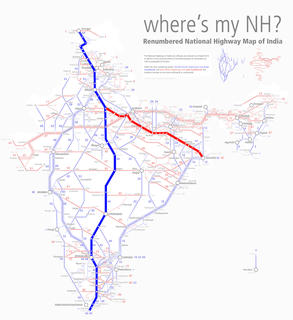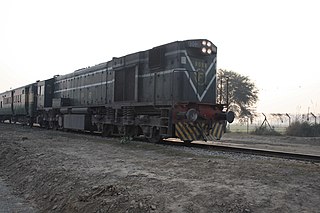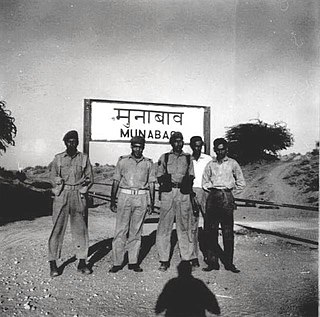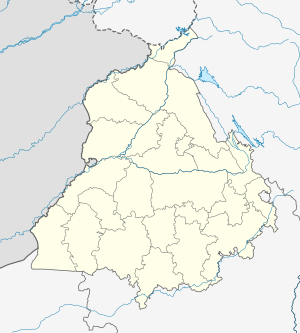
The Grand Trunk Road is one of Asia's oldest and longest major roads. For at least 2,500 years it has linked Central Asia to the Indian subcontinent. It runs roughly 2,400 km (1,491 mi) from Teknaf, Bangladesh on the border with Myanmar west to Kabul, Afghanistan, passing through Chittagong and Dhaka in Bangladesh, Kolkata, Prayagraj, Delhi, and Amritsar in India, and Lahore, Rawalpindi, and Peshawar in Pakistan.

The Samjhauta Express is a bi-weekly train — Thursday and Monday — that runs between Delhi and Attari in India and Lahore in Pakistan. The word Samjhauta means "agreement", "accord" and "compromise" in both Hindi and Urdu.

Wagah or Wagha is a village and union council located in the WahgaZone of, near Lahore City District, Pakistan. The town is famous for the Wagah border ceremony and also serves as a goods transit terminal and a railway station between Pakistan and India. Wahga is situated 600 metres (2,000 ft) west of the border and lies on the historic Grand Trunk Road between Lahore and Amritsar in India. The border is located 24 kilometres (15 mi) from Lahore and 32 kilometres (20 mi) from Amritsar. It is also 3 kilometres (1.9 mi) from the bordering village of Attari, India. The Wagah ceremony takes place every evening.

Majha is a region located in the central parts of the historical Punjab region split between India and Pakistan. It extends north from the right banks of the river Beas, and reaches as far north as the river Jhelum. People of the Majha region are given the demonym "Mājhī" or "Majhe vale". Most inhabitants of the region speak the Majhi dialect, which is the basis of the standard register of the Punjabi language. The most populous city in the area is Lahore on the Pakistani side, and Amritsar on the Indian side of the border.

The India–Pakistan border is the international boundary that separates India and Pakistan. At its northern end is the Line of Control, which separates Indian-administered Kashmir from Pakistani-administered Kashmir; and at its southern end is Sir Creek, a tidal estuary in the Rann of Kutch between the Indian state of Gujarat and the Pakistani province of Sindh.

Munabao is a Bordering Village, just 125 km from Barmer city in the Barmer district in Rajasthan, India. It has bordering Pakistan. It is one of the designated border crossing between two nations, where a daily beating retreat border ceremony is held. Munabao is served by the Munabao railway station on Marwar Junction–Munabao line, through which once-a-week Thar Express train used to run between India and Pakistan (Karachi), passing through Munabao on India side, Zero Point border station, Khokhrapar on Pakistan side.
Moreh is a border town located on the India–Myanmar border in Tengnoupal district of the Indian state of Manipur.

Attari, also spelled Atari, is a village of Amritsar district in the Punjab state of India, 3 km from the Indo-Pakistani border at Wagah. It is situated 25 km west of the Sikh holy city of Amritsar, and is the last Indian station on the rail route connecting Lahore, Pakistan with the Indian capital Delhi. Attari village was the native village of Sardar Sham Singh Attariwala, one of the generals in the Army of Maharaja Ranjit Singh.
Transport between India and Pakistan has been developed for tourism and commercial purposes and bears much historical and political significance for both countries, which have possessed few transport links since the partition of India in 1947. In 2019, all public transport links between the two countries were severed because of Pakistani fury at India's revocation of special status for Kashmir. The only way for travelers to make this journey is to cross on foot at Wagah.
Gede is the last railway station on the Indian side of the Bangladesh–India border in Krishnaganj CD Block in Nadia district in the Indian state of West Bengal. The corresponding station on the Bangladesh side is Darshana. It is the terminal station on the Sealdah–Gede section of Kolkata Suburban Railway system. There is a border checkpoint at Gede.

Pul Kanjri is a historical site situated 35 km away from Amritsar on Amritsar-Lahore road, near the villages of Dhanoa Khurd and Dhanoa Kalan on the Wagah border. It is one of the heritage sites built by Maharaja Ranjit Singh, where he used to rest while travelling with his troops. During his reign, Pul Kanjari was an important trading centre. The legend has it when Maharaja Ranjit Singh married Begum Gul Bahar, on their way to Lahore they had to cross this canal on Ravi river. People used to cross the canal by foot but Begum Gul Bahar refused to do so. Since Maharaja Ranjit Singh was deeply in love with Begum Gul Bahar, he had a small bridge built for her. Some part of the bridge still exists. It was named Pul Kanjri. It was greatly in news during 1971 war. This fortress also contains a bathing pool, a temple, a Gurudwara and a mosque.

The lowering of the flags ceremony at the Attari-Wagah border is a daily military practice that the security forces of India and Pakistan have jointly followed since 1959. The drill is characterized by elaborate and rapid dance-like manoeuvres and raising legs as high as possible, which have been described as "colourful". It is both a symbol of the two countries’ rivalry, and a display of brotherhood and cooperation between the two nations.
Mahisasan is a border railway station and a defunct railway transit facility point on the India–Bangladesh border in Karimganj district in the Indian state of Assam. The corresponding station on the Bangladesh side is Shahbajpur in Sylhet District. The border station is linked to Karimganj 11 kilometres (6.8 mi) away. The Mahisasan–Shahbajpur route has not been operational since December, 1996 due to lack of traffic.
Wagah railway station is located in Wagah, Punjab, Pakistan. It is the last station in Pakistan on the Lahore–Wagah Branch Line and serves as the border station before crossing into India. Wagah serves as a sub-urban station of Lahore and is also used for immigration and custom of passengers who travel between India and Pakistan via Samjhauta Express.

The Ambala–Attari line is a railway line connecting Ambala Cantonment in the Indian state of Haryana and Attari in Punjab. The line is under the administrative jurisdiction of Northern Railway.

Amritsar Junction railway station is a railway junction located in Amritsar district in the Indian state of Punjab and serves Amritsar. It is the largest and busiest railway station of Punjab.
Jiribam railway station serves Jiribam town and belongs to the Lumding railway division of Northeast Frontier Railway. It is the first railway station in the state of Manipur, India.
Amritsar Attari Passenger is a passenger Train of Indian Railways, which runs between Amritsar railway station of Punjab and Atari Shyam Singh railway station of Punjab.
India shares borders with several sovereign countries; it shares land borders with China, Afghanistan, Bhutan, Nepal, Pakistan, Bangladesh and Myanmar. Bangladesh and Pakistan share both land borders as well as maritime borders, while Sri Lanka shares only a maritime border through Ram Setu. India's Andaman and Nicobar Islands share a maritime border with Thailand, Myanmar and Indonesia.
Indian Railways jointly operates passenger and freight services with its neighboring countries. Railway line construction, maintenance, border check point management is also carried out with partner railway agencies and other government agencies. Some of the railway lines & services are operational while some are non-operational or in proposal or planning stages.













